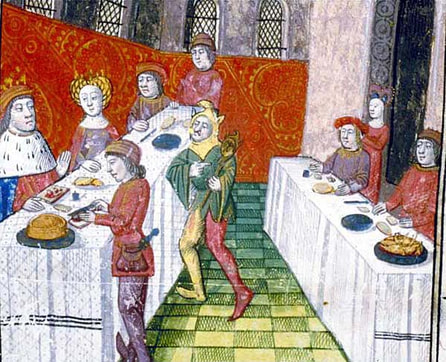The Peculiar Past of Pies
|
Lifting the lid off a coffin was a pleasant experience in England during the Middle Ages. A coffin or coffyn referred to a container made of pastry, a precursor of the modern pie crust, and food was served in the coffin it had been cooked in. The first printed use of the word coffin as a box for a corpse appeared later, in the 16th century.
Historians trace pies back to ancient times. The Greeks wrapped dough made of flour and water around meat to seal in the juices. The Romans continued that tradition and spread it across Europe. The word pie or pye supposedly comes from magpie, the bird that collects odds and ends of its nest, just as cooks put everything they had into a pie. A recipe from 1450 mentions beef, hens, rabbits, suet, egg yolks, dates, and prunes as some of the ingredients in a single high and hearty “pye.” |
|
The Italian Banquet, a book from the late 16th century, refers to a pie filled with live birds. To make this showy treat, the baker put a fist-sized hole in the bottom of the pastry coffin and sealed up the opening. After cooking and cooling the pie, the baker stuffed live birds in the hole, so that when it was cut for serving, the birds would fly out. The crust of these savory pies had to be dense enough to withstand hours of heat. The coffin served as a casserole dish, making meat more tender and delicious than hunks of dry roasted meat. But the pastry itself was tasteless and too hard and thick to chew.
As sugar and fat became more available and affordable, the dough containers morphed into the edible pie crusts we know today. By the time the English established colonies across the Atlantic, less heavy dough, a short crust, was common with sweet as well as savory fillings. According to Matt Siegel in The Secret History of Food, the scarcity of wheat in the New England colonies meant that cooks had to stretch the pastry for pies so it became thin and flaky. It's still true that British pie crusts tend to be thicker and denser than American crusts. |
By the 19th century Americans were used to the lighter crusts on their side of the Atlantic, judging by Mark Twain's snarky “Recipe for an English Pie” in his 1880 book, A Tramp Abroad: “Take a sufficiency of water and a sufficiency of flour, and construct a bullet-proof dough. ...Toughen and kiln-dry in a couple days ... Fill with stewed dried apples; aggravate with cloves, lemon-peel, and slabs of citron; add two portions of New Orleans sugars, then solder on the lid and set in a safe place till it petrifies. Serve cold at breakfast and invite your enemy.”

